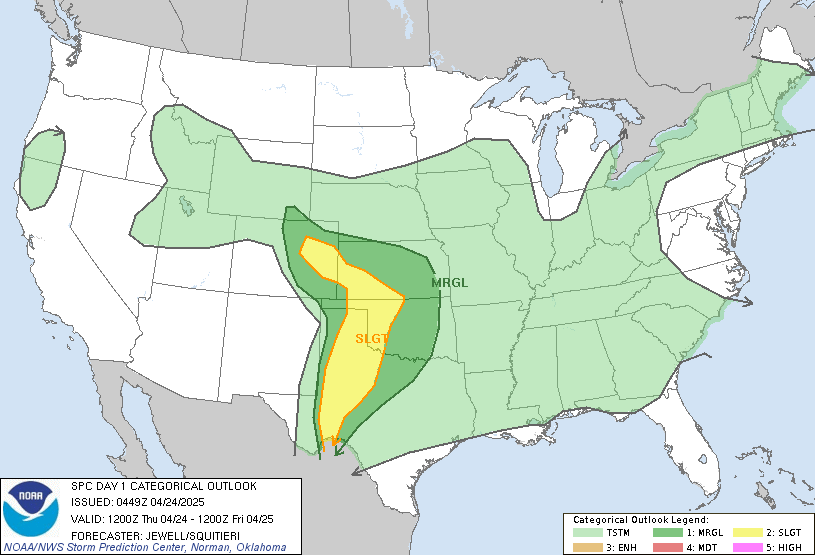LIVE MAP (ABOVE) ... SPC 1300Z Day 1 Outlook
Day 1 Convective Outlook
NWS Storm Prediction Center Norman OK
0742 AM CDT Mon Aug 21 2023
Valid 211300Z - 221200Z
...THERE IS A MARGINAL RISK OF SEVERE THUNDERSTORMS ACROSS PARTS OF
THE INTERIOR WEST MAINLY DURING THE AFTERNOON...AND PARTS OF THE
UPPER MIDWEST AND LOWER/MIDDLE TEXAS COAST OVERNIGHT...
...SUMMARY...
Locally severe thunderstorms are possible across parts of the
Interior West mainly during the afternoon, and parts of the Upper
Midwest and lower/middle Texas Coast overnight.
...Synopsis...
The middle/upper-level pattern over the CONUS will remain dominated
by a large-scale anticyclone, which had a 500-mb high of 604
decameters just north of TOP, on last night's 00Z manual chart
analysis. This high is expected to remain at or above 600
decameters through the remainder of the period, while drifting
erratically around the TOP/STJ/MKC vicinity, before shifting south
and weakening somewhat on day 2. North of the high, ridging should
amplify somewhat over the Dakotas today, making the flow over the
Upper Great Lakes more northwesterly.
Meanwhile, a broad but weak mid/upper cyclone -- initially centered
just offshore from SFO -- is expected to move little before 12Z
tomorrow, but devolve into an open shortwave trough, as another low
digs southeastward just offshore from Vancouver Island. In between
the low and high, a broad channel of fast flow aloft and low/middle-
level moisture will persist today across the Desert Southwest and
Great Basin, becoming southwesterly across the northern Rockies.
Farther southeast, a well-defined low/middle-level trough, with some
potential to develop into a tropical cyclone, will move westward
from the central Gulf, reaching the lower TX Coast near the end of
the period or early day 2. See latest NHC tropical weather outlooks
for more on that system.
At the surface, 11Z analysis showed a cold front from northern ME
across the Lower Great Lakes to northern IN, becoming a
quasistationary to warm front from there over northern IL, southern/
western IA and southern SD, to a low near TOR. This front should
move northward as a warm front over eastern SD, southern MN and
parts of IL/WI, as the low migrates east- northeastward to
east-central/northeastern SD by 12Z tomorrow.
...AZ-MT corridor...
Isolated to scattered thunderstorms are expected to pose a marginal
severe-wind threat this afternoon into evening, within a long plume
from the southern AZ border, up through the eastern Great Basin and
Star Valley/Teton/Yellowstone corridor to parts of southern MT.
Though the remains of TC Hilary are expected to continue ejecting
northward and becoming less distinct today, the enhanced southerly
flow belt farther east will continue to yield seasonally strong
deep-layer southerlies, as noted above. This should enable downward
momentum transfer to the ground, especially in more intense/
persistent cells within a lengthy, broken plume of surface-based
convection developing in the diurnal heating cycle. Heating should
be stronger and more persistent along the eastern rim of the
favorable moist plume, which is approximately represented by this
outlook. Peak/preconvective MLCAPE should range from around 300-800
J/kg over the UT-MT part of this corridor, to 1000-1500 J/kg across
AZ.
...Upper Midwest...
Widely scattered to scattered thunderstorms are expected to develop
this evening and overnight, moving east-southeastward across the
outlook area while offering isolated, marginal potential for severe
hail. After 00Z, as the upstream boundary layer decouples and a
southwesterly LLJ develops/intensifies, associated isentropic lift
of an increasingly moist air mass to LFC should occur, amidst
elevated frontal forcing northeast of the surface boundary. Time
series of forecast soundings suggest that, above a stable surface-
850-mb layer and away from convection, continual steepening of
low/middle-level lapse rates will occur. This should result mainly
from elevated low-level warm advection, but also, slight cooling in
midlevels. Elevated MUCAPE in the 1500-2500 J/kg range may develop,
collocated with 40-50-kt effective-shear magnitudes. This can
support organized thunderstorms with hail, though potentially
expansive, messy storm mode may limit local duration/magnitude of
the hail threat.
...Portions of mid/lower TX Coast...
Isolated supercells may reach the immediate coastal areas on ether
side of CRP the last few hours of the period (late overnight/early
morning). Though uncertainty remains regarding the evolution of the
Gulf trough into a potential tropical system (per NHC forecasts), a
belt of enhanced low-level gradient flow should strengthen along its
northern rim. This process may expand low-level hodographs enough
to support storm-scale rotation in cells approaching the coast in
the last few hours of the period, as a start to the more extensive/
inland (but for now still marginal) tornado potential discussed in
the day-2 outlook.
..Edwards/Jewell.. 08/21/2023
Read more CHECK UPDATE ZOOM GRAPHIC
http://dlvr.it/StyK1l
Windy.com Temps | Gusts | WU KORD KPWK |
CLICK for this month's BIG night sky ... | RADAR FULL MAP SCREEN |
|---|
MOBILE DEVICE? Turn sideways. Weather conditions directly above are near Lakefront. Top tabs refer to O'Hare (official).
Archives for the SPC Convective Outlook are updated daily (approximately) with a live map at the beginning of each article. Follow the link at the end of the article to check for current updates on the NOAA/NWS Storm Prediction Center website. Also, see Archives for Chicago's hourly weather data on CARDINAL NEWS Magazine.
CONVECTIVE | TORNADO | WIND | HAIL
O'Hare International Airport KORD
(Arlington Heights South)
Chicago Executive Airport KPWK
(Arlington Heights North)
Monday, August 21, 2023
SPC Aug 21, 2023 1300 UTC Day 1 Convective Outlook
SUNRISE AND SUNSET TIMES IN UTC (if you're not logged in to Google)
CHICAGO UTC-6 during CST (Central Standard Time, e.g., winter)
CHICAGO UTC-5 during CDT (Daylight Savings Time, e.g., summer)
CHICAGO UTC-6 during CST (Central Standard Time, e.g., winter)
CHICAGO UTC-5 during CDT (Daylight Savings Time, e.g., summer)





















